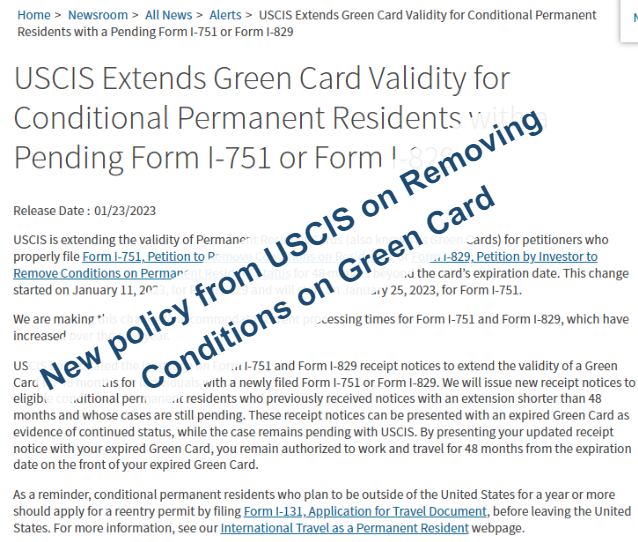This is a recent update posted on the Official Twitter account of U.S. Citizenship and Immigration Services (USCIS) concerning how to apply U.S Work Permit if Paroled as a Cuban, Haitian, Nicaraguan, or Venezuelan.
Its read…..
“If you were paroled into the U.S. through the processes for Cubans, Haitians, Nicaraguans, and Venezuelans, then you can apply for a work permit. You can begin the application process by creating a USCIS online account and filing Form-I-765 online.”
Paroled into the U.S. as a Cuban, Haitian, Nicaraguan, or Venezuelan? With this recent update from USCIS, you can now Apply for a Work Permit.
The recent update from USCIS further state below:
You are likely eligible to apply for an employment authorization document (EAD) to legally work in the United States if:
- You were recently paroled into the United States and that parole remains valid; or
- You have applied for asylum and that application has been pending for at least 150 days.
If you have not already started the EAD application process, you can begin by creating a USCIS account online and filing Form-I-765. USCIS will mail your work permit to the address you provided in your application if your application is approved. If necessary, you can file a paper application for Form I-765 instead.
If you are an Afghan national paroled into the United States and you are applying for employment authorization, you will need a Social Security number (SSN) to work in the United States. Your SSN allows employers to report your earnings to the U.S. government.
Apply for an SSN (or replacement SSN card) using Form I-765, Application for Employment Authorization, and following the form instructions.
If you do not request an SSN in Part 2 (Items 14-17.b) of your Form I-765, you must make an appointment to visit a Social Security Administration office in person to apply for your SSN after you receive your Employment Authorization Document (Form I-766).
Certain noncitizens who are in the United States may file Form I-765, Application for Employment Authorization, to request an Employment Authorization Document (EAD). Other noncitizens whose immigration status authorizes them to work in the United States without restrictions may also use Form I-765 to apply for an EAD that shows such authorization.
See more about the I-765, Application for Employment Authorization update from USCIS here.
What Is Form I-765, Application for Employment Authorization?
Form I-765, Application for Employment Authorization, is a form submitted to USCIS to request employment authorization and an Employment Authorization Document (EAD).
To explain more about what Form I-765 is, how it’s used, who can file the form, how to complete it, what supporting documents to include, and how much it costs.
Form I-765 is main official form you use to apply for a work permit. A work permit is formally called an Employment Authorization Document or EAD. To receive an Employment Authorization Document (EAD), you need to file Form I-765 with U.S. Citizenship and Immigration Services (USCIS).
USCIS uses this form to collect information from people applying for work authorization to assess whether or not they are eligible for a work permit.
You can’t get an EAD without filing Form I-765 with USCIS. Without work authorization, you can’t work for any employer in the United States. When USCIS processes and approves your Form I-765 application, they will issue you a card that you can use as proof of your eligibility to work for employers in the United States. You’ll also use Form I-765 to renew an expired EAD or to replace a missing or damaged EAD.
Do You Need To Include Any Supporting Documents With Form I-765?
You’ll need to include some supporting documents with Form I-765 when you file it with USCIS. The documents you need will depend on the work permit eligibility category you’re applying under. The USCIS website has a full, comprehensive list of the specific documents they want from you based on your eligibility category.
Required Supporting Documents for Form I-765
All applicants must submit these documents:
- Two recent passport-sized photographs
- A photocopy of your I-94 record (front and back)
- Arrival/Departure Record
- A copy of your passport or travel document
- A photocopy of your most recent EAD card if you have or ever had one.
Review these requirements before completing and submitting your form. Do not send original documents unless specifically requested in the form instructions or applicable regulations.
If you submit any documents (copies or original documents, if requested) in a foreign language, you must include a full English translation along with a certification from the translator verifying that the translation is complete and accurate, and that they are competent to translate from the foreign language to English.
Disclaimer: This is not the official website of USCIS and this site is not affiliated to USCIS. The information above are extracted from USCIS Official Twitter account and officially webpage.
 Jobsscholar Jobs Search | Education Hub | Scholars Portal
Jobsscholar Jobs Search | Education Hub | Scholars Portal
